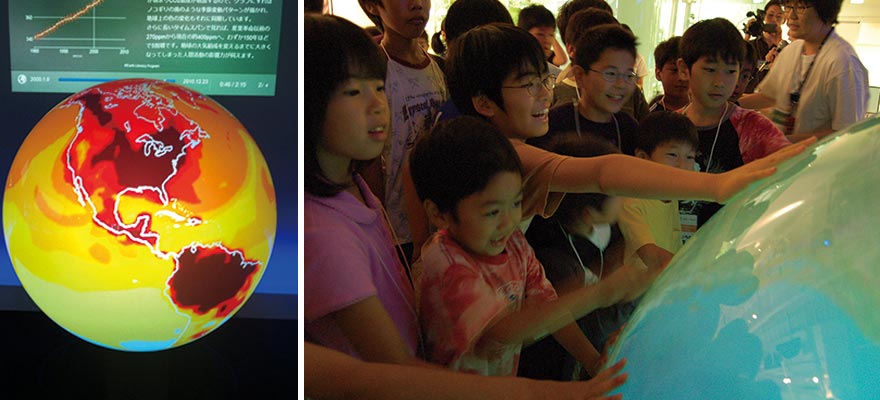Home > Highlighting JAPAN >Highlighting Japan March 2014>Creative roots
Highlighting JAPAN
Creative roots
Tangible Earth
Interactive technology nurtures a global perspective

On display in the Marunouchi area of Tokyo until August 2014, the centerpiece of the Tangible Earth Museum is a digital world globe that provides real-time data on an interactive, spherical display. Through simple hand gestures, users can retrieve and present information within the display itself, with global environmental information accessed directly through the Internet. The world comes alive with flowing visualizations of events, from earthquakes, tsunami and even bird migrations to continental drift, global warming and the cross-border circulation of PM2.5, the fine particulate matter that makes up some forms of air pollution.
The device is the brainchild of Shinichi Takemura, professor at the Kyoto University of Art and Design and director of the non-profit Earth Literacy Program. The idea evolved from a website Professor Takemura developed in 1996 in response to 1995's Great Hanshin-Awaji Earthquake; he aimed to provide a platform for viewing the onset of earthquakes anywhere in the world. He says he thought at the time, "If earthquakes could be made visible to Japanese people on a global scale, it could change our awareness of our planet."
Building on this concept, Takemura was convinced of the need for a tactile device that could visualize the earth in even more detail, and decided to develop it in the form of a world globe. After constructing a prototype in 2002, he completed a full-size version of the Tangible Earth in 2005. With a diameter of 1.28 meters, one ten-millionth of the actual size of our planet, Tangible Earth reduces the thickness of our 10-kilometer troposphere to precisely 1 millimeter.
Takemura's intention wasn't to produce a world globe but create a world of people who are true citizens of the Earth. He was motivated by what he saw as a need for a tool that would encourage thinking on a global scale. "Just as the world was changed by the invention of the letterpress and the completion of our world map during the Age of Discovery, I hope this Tangible Earth will stimulate an increase in people who can think from a truly global perspective."
Developed in collaboration with GK Tech Inc., which specializes in applying innovative technology to creative design, the full-scale Tangible Earth was exhibited in Nagoya at Expo 2005 Aichi, Japan – fittingly referred to in Japanese as 'Ai-Chikyu Haku,' a play on the words 'Aichi' and chikyu, or 'Earth.' Tangible Earth won the Good Design Gold Award for that year. The globe also garnered attention at the 2008 G8 Hokkaido Toyako Summit, where it became a special attraction at the on-site media center.
2013 saw the announcement of a medium-size (80-centimeter diameter) Tangible Earth jointly developed by Takemura and JVCKENWOOD Corporation. Designed for educational institutions, museums, planetariums and other public facilities, it was only shortly after its release that the medium-size Tangible Earth received the Prime Minister's Prize for Excellence at the Kids Design Award 2013.
Takemura describes the Tangible Earth as a platform that amasses the best of Japanese technology. Components, such as the interior projector and the sensor that follows hand gestures to rotate the globe, are products of Japan's outstanding domestic capabilities; while even the semitransparent acrylic dome incorporates original rear-projection technology that conforms to the world's highest standards.
Furthermore, the actual contents of the Tangible Earth represent the aggregate of Japan's top scientific data. Organizations, such as the Japan Aerospace Exploration Agency (JAXA), the Japan Agency for Marine-Earth Science and Technology (JAMSTEC), Weathernews Inc. and the National Institute for Environmental Studies (NIES), provide over 100 forms of cutting-edge scientific readings on global environmental conditions and climate change. "This is why it's so meaningful to send the Tangible Earth out to the world," Takemura says.
This Cool Japan innovation isn't designed for gazing inward at Japan. Rather, it teaches the importance of linking Japan with the world as we view our planet from the perspective of global citizens of Earth.
© 2009 Cabinet Office, Government of Japan






